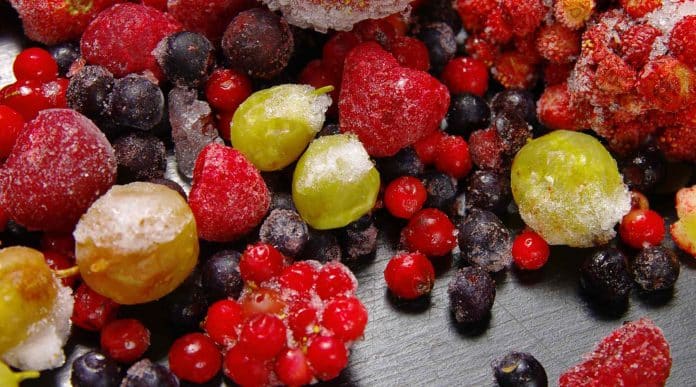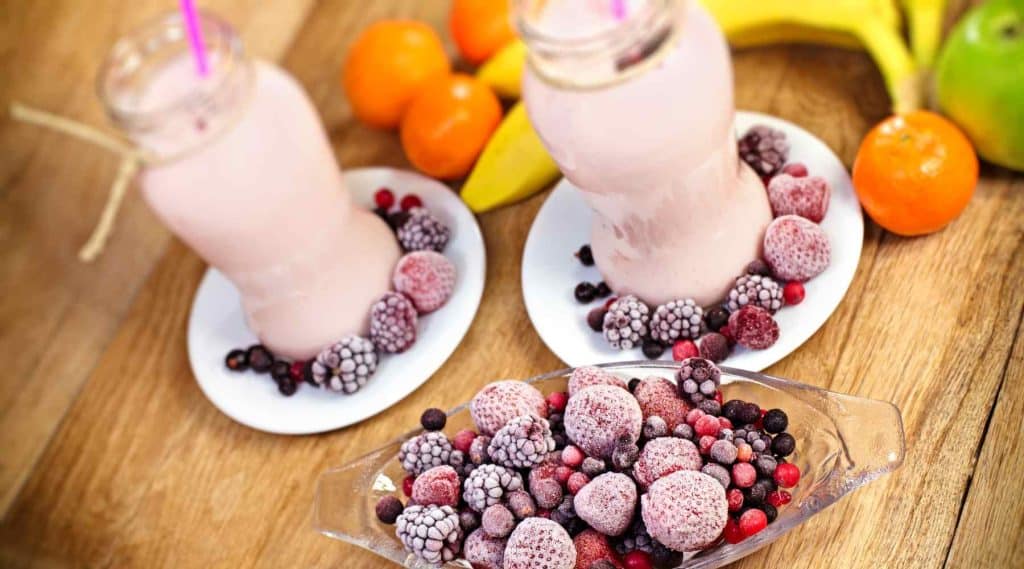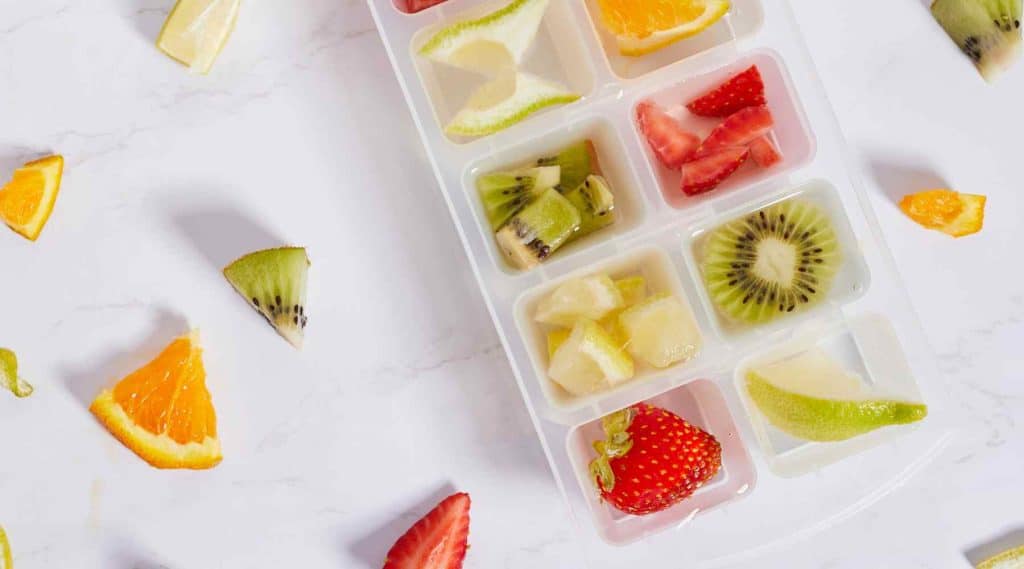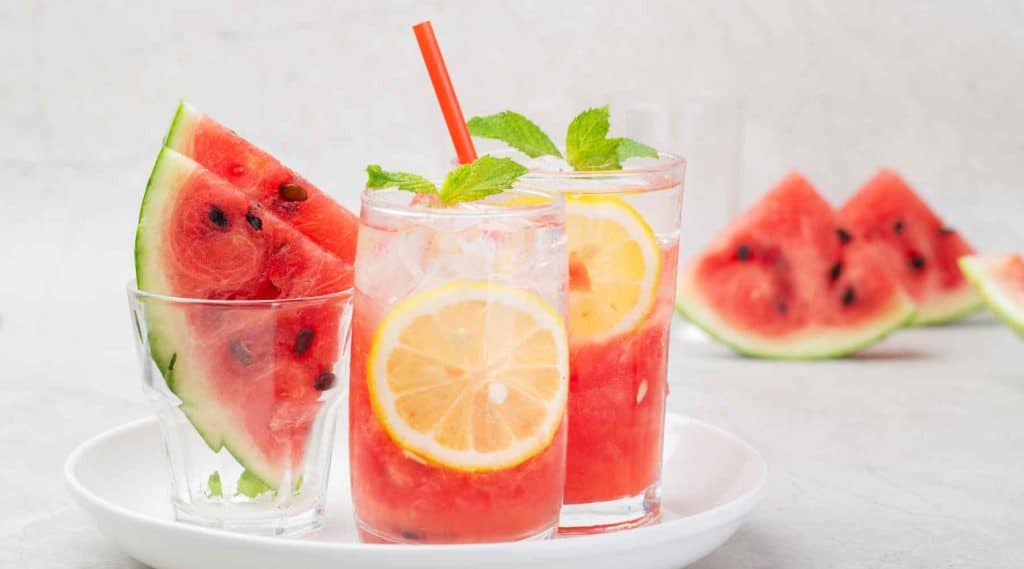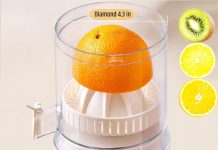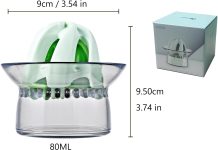Have you ever wondered if it’s possible to juice frozen fruits and vegetables? Well, the answer is yes! Many people enjoy the convenience and availability of frozen produce, but are hesitant to use them in juicing. However, freezing fruits and vegetables can actually help preserve their nutrients and make them last longer. Whether you want to whip up a refreshing smoothie or add a nutritious boost to your juice, using frozen produce can be a game-changer. In this article, we will explore the benefits of juicing with frozen fruits and vegetables and share some helpful tips to ensure you get the most out of your juicing experience. So, let’s unpack the world of juicing with frozen delights!
This image is property of littlewest.com.
Review contents
Benefits of Juicing Frozen Fruits and Vegetables
At first, you might wonder if it’s possible to juice frozen fruits and vegetables. Well, we’re here to tell you that not only is it possible, but it also offers several benefits! Let’s dive into why juicing frozen produce can be a wonderful addition to your healthy lifestyle.
Retains Nutritional Value
One of the most significant advantages of juicing frozen fruits and vegetables is that it helps retain their nutritional value. When fruits and vegetables are frozen, their nutrients remain intact. The freezing process locks in vitamins, minerals, and antioxidants, ensuring that they are preserved until you’re ready to juice them. This means that even if you can’t find fresh produce, you can still enjoy the same health benefits by using frozen alternatives.
Convenience and Accessibility
Juicing frozen produce offers unparalleled convenience and accessibility. It’s not always easy to find a wide variety of fresh fruits and vegetables, especially during certain seasons or in remote areas. However, frozen fruits and vegetables are available year-round and can be conveniently stored in your freezer. This accessibility makes it easier for you to maintain a healthy juicing habit, regardless of the time of year or your location.
Cost-Effective
Another wonderful benefit of juicing frozen fruits and vegetables is that it can be cost-effective. Fresh produce can sometimes be expensive, especially if you’re looking for exotic or out-of-season fruits and vegetables. By opting for frozen alternatives, you can significantly reduce your grocery bill while still enjoying the same nutritional benefits. Additionally, since frozen produce has a longer shelf life, you’ll waste less food and save money in the long run.
Extended Shelf Life
Speaking of shelf life, using frozen fruits and vegetables for juicing allows for an extended shelf life. Fresh produce can spoil quickly, especially if not used within a few days. However, frozen produce can be stored for months without losing its nutritional value. This extended shelf life not only eliminates food waste but also allows you to stock up on the fruits and vegetables you love whenever they’re on sale, ensuring that you always have ingredients ready for a healthy and refreshing juice.
Versatility in Recipes
Juicing frozen fruits and vegetables also provides versatility in your recipes. By using frozen produce, you open up a world of possibilities when it comes to flavors and combinations. You can mix and match different fruits and vegetables and experiment with new flavors that might not be available in fresh produce. Plus, frozen produce can be used to create smoothies, desserts, and even soups, giving you endless options to explore and enjoy.
Factors to Consider before Juicing Frozen Produce
While juicing frozen fruits and vegetables has numerous benefits, there are a few factors you should consider to ensure the best juicing experience. Let’s take a closer look at these factors.
Quality of Frozen Produce
The quality of frozen produce is crucial when it comes to juicing. It’s essential to choose high-quality frozen fruits and vegetables that have been properly frozen and stored. Look for brands that freeze their produce at peak ripeness, as this ensures maximum flavor and nutritional value. Additionally, examine the packaging for any signs of freezer burn or ice crystals, as these can indicate poor quality.
Preparation Methods
Before juicing frozen produce, it’s essential to prepare it correctly. Thawing the frozen fruits and vegetables is usually necessary to achieve the desired consistency. Depending on the texture you desire in your juice, you can choose to partially thaw or fully thaw the produce. Partially thawed produce will result in a thicker and more frosty juice, while fully thawed produce will yield a smoother and more liquid-like consistency.
Compatibility with Juicer
Not all juicers are designed to handle frozen produce, so it’s crucial to ensure that your juicer is compatible before attempting to juice frozen fruits and vegetables. Centrifugal juicers, which are popular for their high extraction speed, may struggle with harder frozen produce. On the other hand, masticating juicers, known for their slow and thorough juicing process, are more suitable for juicing frozen fruits and vegetables. Consider the capabilities of your juicer and its intended use before incorporating frozen produce into your juicing routine.
Texture and Consistency
The texture and consistency of your juice may be slightly different when using frozen produce compared to fresh produce. Frozen fruits and vegetables can create a thicker juice, similar to a smoothie, due to the added ice content. This can be desirable for those who enjoy a frosty and refreshing beverage. However, if you prefer a more traditional juice consistency, you may want to dilute the frozen produce with liquid or mix it with fresh ingredients.
Recommended Techniques for Juicing Frozen Produce
Now that we understand the benefits and factors to consider when juicing frozen produce, let’s explore some recommended techniques to ensure the best results. By following these techniques, you can create delicious and nutritious juices from your frozen fruits and vegetables.
Thawing
Thawing is an important step when juicing frozen produce. While some juicers may be able to handle fully frozen fruits and vegetables, it’s generally recommended to thaw them slightly for optimal juicing results. To thaw your frozen produce, simply leave it in the refrigerator overnight or let it sit at room temperature for a few hours. Alternatively, you can use a microwave on the defrost setting for quicker thawing. Just remember that the longer you thaw the produce, the smoother the consistency of the juice will be.
Blending vs. Juicing
When it comes to juicing frozen produce, you have a choice between blending and juicing. Blending involves using a high-powered blender to create a smoothie-like consistency, whereas juicing involves extracting the liquid from the fruits and vegetables while leaving behind the pulp. Both methods have their own merits, and the choice depends on personal preference. Blending allows you to consume the whole fruit or vegetable, including the fiber, while juicing provides a more concentrated and nutrient-rich beverage. Experiment with both methods to see which one suits your taste and health goals.
Adding Liquid
To achieve the desired consistency and flavor, it may be necessary to add a liquid when juicing frozen produce. Frozen fruits and vegetables contain ice, which can result in a thicker juice. To balance the texture, you can add liquid such as water, coconut water, almond milk, or fruit juice to dilute the mixture. The amount of liquid you add will depend on your personal preference, so feel free to adjust it as needed. Adding liquid not only helps create the ideal consistency but also contributes to the overall flavor profile of the juice.
Mixing with Fresh Ingredients
While using frozen produce is convenient, mixing it with fresh ingredients can enhance both the flavor and nutritional value of your juice. By combining frozen fruits and vegetables with fresh counterparts, you can create a well-rounded and balanced juice. Fresh ingredients can add a burst of natural sweetness, acidity, or even a hint of bitterness to your juice, enhancing its overall taste profile. Experiment with different combinations to find your favorite blend of frozen and fresh ingredients.
Best Fruits for Juicing when Frozen
Certain fruits work exceptionally well when juiced from their frozen state. Let’s explore some of the best fruits to use for juicing when they are frozen.
Berries (Strawberries, Blueberries, Raspberries)
Berries, such as strawberries, blueberries, and raspberries, are fantastic for juicing when frozen. They are naturally sweet and packed with antioxidants and vitamins. Frozen berries are also perfect for creating vibrant and colorful juices, adding a delightful burst of flavor.
Citrus Fruits (Oranges, Lemons, Limes)
Citrus fruits, including oranges, lemons, and limes, are another excellent choice for juicing when frozen. They provide a refreshing and tangy flavor that pairs well with other fruits and vegetables. Frozen citrus fruits can also be used to create zesty and invigorating juices that are perfect for a morning pick-me-up.
Tropical Fruits (Pineapple, Mango, Papaya)
If you’re looking for a taste of the tropics, consider using frozen tropical fruits for juicing. Pineapple, mango, and papaya are not only delicious but also offer a range of health benefits. They add a tropical twist to your juices and create a vacation-like experience with every sip.
Stone Fruits (Peaches, Plums, Cherries)
Stone fruits such as peaches, plums, and cherries are juicy and flavorful when juiced from their frozen state. These fruits add a natural sweetness and a pleasant tartness to your juice. Whether enjoyed on their own or mixed with other fruits and vegetables, they add a burst of summery flavors to your juicing experience.
This image is property of cdn.shopify.com.
Vegetables That Juice Well when Frozen
In addition to fruits, many vegetables are also suitable for juicing when frozen. Let’s explore some of the top vegetables that juice well when they are frozen.
Leafy Greens (Spinach, Kale, Swiss Chard)
Leafy greens like spinach, kale, and Swiss chard are packed with vital nutrients and make a great addition to any juice. When frozen, these greens retain their nutritional value and add a fresh and vibrant taste to your concoctions.
Root Vegetables (Carrots, Beets, Sweet Potatoes)
Root vegetables such as carrots, beets, and sweet potatoes are not only delicious when cooked but also fantastic for juicing when frozen. They provide a natural sweetness and earthy flavor to your juices. Juicing frozen root vegetables also adds a rich color and depth to your beverage.
Cruciferous Vegetables (Broccoli, Cauliflower, Brussels Sprouts)
Cruciferous vegetables like broccoli, cauliflower, and Brussels sprouts are well-known for their health benefits, and juicing them when frozen is a convenient way to incorporate them into your diet. These vegetables add a distinctive taste and texture to your juice, making it a delightful and nutrient-packed drink.
Bell Peppers
Bell peppers, with their vibrant colors and crisp texture, can be an unexpected and refreshing addition to your frozen produce juice. They add a slightly tangy and mildly sweet flavor, creating a unique taste profile. Whether you choose red, yellow, or green bell peppers, they are a great way to diversify your juicing routine.
Tips for Enhancing the Flavor and Texture
While juicing frozen produce offers a multitude of flavors and textures, there are several ways to further enhance the taste and consistency of your juices. Let’s explore some tips for taking your frozen produce juice to the next level.
Mixing Complementary Flavors
To create a balanced and harmonious flavor profile, consider mixing complementary flavors in your juice. For example, pair sweet fruits like mangos and pineapples with tangy citrus fruits like lemons and oranges. Similarly, you can add a touch of natural sweetness to a green juice by including apples or pears. Mix and match different fruits and vegetables to discover delicious combinations that suit your taste buds.
Adding Herbs and Spices
Herbs and spices can provide a unique and aromatic twist to your frozen produce juice. Fresh herbs like mint, basil, or cilantro can add a burst of freshness, while spices like ginger, turmeric, or cinnamon can enhance the flavor and offer additional health benefits. Start with small quantities and gradually adjust to achieve the desired taste.
Using Nut Milk or Yogurt
If you prefer a creamier and thicker texture, consider adding nut milk or yogurt to your frozen produce juice. Nut milk, such as almond or cashew milk, can lend a subtle nuttiness and creaminess to the juice. Similarly, yogurt can provide a tangy and velvety consistency. These additions not only enhance the texture but also contribute to the overall taste and nutritional value of your juice.
Balancing Thickness with Liquid
Frozen produce can create a thicker juice due to the added ice content. If you prefer a more liquid-like consistency, you can balance the thickness by adding liquid. Water, coconut water, fruit juice, or even herbal tea can be used to dilute the juice and achieve the desired consistency. Feel free to experiment with different liquids to find the perfect balance that suits your taste.
This image is property of cdn.shopify.com.
Potential Drawbacks of Juicing Frozen Produce
While juicing frozen fruits and vegetables offers many benefits, it’s essential to acknowledge a few potential drawbacks. Let’s explore these considerations to help you make an informed decision about incorporating frozen produce into your juicing routine.
Loss of Freshness
Juicing frozen produce may result in a loss of freshness compared to using fresh produce. Fresh fruits and vegetables are typically plucked at their peak ripeness, whereas frozen produce may undergo some degree of processing and freezing before reaching your juicer. This processing can affect the taste and aroma of the juice, although the nutritional value is still preserved.
Quality Variation
The quality of frozen produce can vary depending on the brand and storage conditions. Some frozen fruits and vegetables may lose their consistency or become mushy when thawed, resulting in a less than desirable texture in your juice. To mitigate this issue, make sure to choose high-quality frozen produce from trusted brands and pay attention to the packaging and storage recommendations.
Diluted Flavor
Juices made from frozen produce sometimes have a slightly diluted flavor compared to those made with fresh ingredients. The freezing process can alter the cellular structure of the fruits and vegetables, affecting their taste and intensity. To combat this, consider using more flavorful or aromatic produce when juicing frozen ingredients. You can also enhance the taste by incorporating herbs, spices, or sweeteners to elevate the overall flavor profile.
Effect on Fiber Content
When you juice fruits and vegetables, you remove the insoluble fiber present in the produce. This is true whether the produce is fresh or frozen. While juicing allows for easy digestion and absorption of nutrients, it does result in a decrease in fiber content. If you value the fiber in your diet, consider incorporating other sources of fiber, such as whole grains, legumes, or leafy greens, into your meals.
Storage and Freezing Tips for Future Juicing
If you’re interested in juicing frozen produce on a regular basis, it’s essential to develop proper storage and freezing habits. Let’s explore some tips to ensure the longevity and quality of your frozen fruits and vegetables.
Choosing the Right Containers
When storing your frozen produce, choosing the right containers is crucial. Opt for freezer-safe containers or resealable bags designed for freezing. Make sure the containers are airtight to prevent freezer burn and maintain the quality of the frozen produce. It’s also helpful to portion the fruits and vegetables into individual or small serving sizes for easy access when it’s time to juice.
Labeling and Dating
To avoid confusion and make the most of your frozen produce, label each container with the name of the fruit or vegetable and the date of freezing. This practice ensures that you can easily identify the contents and consume them within the recommended time frame. Remember to rotate your stock and use the older produce first to maintain freshness.
Optimal Freezing Time
While frozen fruits and vegetables have a longer shelf life compared to fresh produce, it’s essential to freeze them at their peak freshness to maintain optimal flavor and nutritional value. Freeze the produce as soon as possible after purchasing or harvesting to lock in their goodness. Avoid freezing overripe or bruised produce, as they may not maintain their quality during freezing and thawing.
Proper Thawing Techniques
Lastly, knowing how to properly thaw your frozen produce is crucial to preserving its quality. Avoid thawing fruits and vegetables at room temperature, as this may promote bacterial growth and compromise safety. Instead, thaw them in the refrigerator overnight or use the defrost setting on your microwave for quicker thawing. Thawed produce should be used as soon as possible to retain the best flavor and texture.
This image is property of northernnester.com.
Safety Precautions and Hygiene
When juicing frozen fruits and vegetables, it’s important to maintain proper safety precautions and hygiene practices. Here are some essential tips to keep in mind.
Washing Frozen Produce
Just like fresh produce, it’s essential to wash frozen fruits and vegetables before juicing them. Rinse them under cool running water to remove any residual chemicals, dirt, or bacteria. This step ensures that your juice is clean and safe to consume.
Maintaining Clean Juicing Equipment
Cleanliness is key when it comes to juicing, regardless of whether you’re using frozen or fresh produce. Regularly clean and sanitize your juicing equipment, including the juicer, blades, and containers, to prevent cross-contamination and maintain optimal hygiene. Follow the manufacturer’s instructions for proper cleaning, or refer to our article on cleaning juicing equipment for detailed guidelines.
Hygienic Food Handling
When handling frozen and fresh produce, it’s crucial to maintain hygienic practices. Wash your hands thoroughly before and after handling the produce to prevent the transfer of bacteria. Use clean cutting boards and knives to prepare the fruits and vegetables, and avoid cross-contamination by keeping them separate from raw meat, poultry, and seafood.
Proper Storage of Juice
If you have leftover juice from your frozen produce, it’s essential to store it properly to prevent spoilage and maintain its quality. Transfer the juice into an airtight, BPA-free container and refrigerate it promptly. Consume the juice within a few days to enjoy its freshness and nutritional benefits.
Conclusion
Juicing frozen fruits and vegetables can be a fantastic way to enjoy the nutritional benefits, convenience, and versatility they offer. By incorporating frozen produce into your juicing routine, you can retain their nutritional value, access a wide range of flavors year-round, and save money in the process. Just remember to consider the quality, choose the right preparation techniques, and experiment with combinations to find your perfect juice. So go ahead, grab your favorite frozen fruits and vegetables, and embark on a delicious and healthy juicing adventure!
This image is property of cdn.shopify.com.

